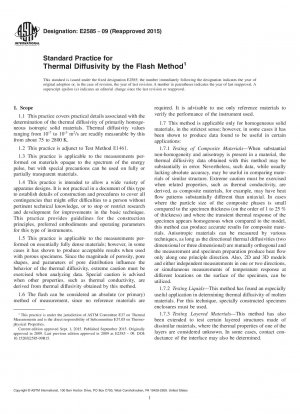ASTM E2585-09(2015)
Standard Practice for Thermal Diffusivity by the Flash Method
- Standard No.
- ASTM E2585-09(2015)
- Release Date
- 2009
- Published By
- American Society for Testing and Materials (ASTM)
- Status
- Replace By
- ASTM E2585-09(2022)
- Latest
- ASTM E2585-09(2022)
- Scope
5.1 Thermal diffusivity is an important property, required for such purposes under transient heat flow conditions, such as design applications, determination of safe operating temperature, process control, and quality assurance.
5.2 The flash method is used to measure values of thermal diffusivity, α, of a wide range of solid materials. It is particularly advantageous because of simple specimen geometry, small specimen size requirements, rapidity of measurement and ease of handling.
5.3 Under certain strict conditions, specific heat capacity of a homogeneous isotropic opaque solid sample can be determined when the method is used in a quantitative fashion (see Test Method E1461, Appendix 1).
5.4 Thermal diffusivity results, together with related values of specific heat capacity (Cp) and density (ρ) values, can be used in many cases to derive thermal conductivity (λ), according to the relationship:

1.1 This practice covers practical details associated with the determination of the thermal diffusivity of primarily homogeneous isotropic solid materials. Thermal diffusivity values ranging from 10-7 to 10-3 m2/s are readily measurable by this from about 75 to 28008201;K.
1.2 This practice is adjunct to Test Method E1461.
1.3 This practice is applicable to the measurements performed on materials opaque to the spectrum of the energy pulse, but with special precautions can be used on fully or partially transparent materials.
1.4 This practice is intended to allow a wide variety of apparatus designs. It is not practical in a document of this type to establish details of construction and procedures to cover all contingencies that might offer difficulties to a person without pertinent technical knowledge, or to stop or restrict research and development for improvements in the basic technique. This practice provides guidelines for the construction principles, preferred embodiments and operating parameters for this type of instruments.
1.5 This practice is applicable to the measurements performed on essentially fully dense materials; however, in some cases it has shown to produce acceptable results when used with porous specimens. Since the magnitude of porosity, pore shapes, and parameters of pore distribution influence the behavior of the thermal diffusivity, extreme caution must be exercised when analyzing data. Special caution is advised when other properties, such as thermal conductivity, are derived from thermal diffusivity obtained by this method.
1.6 The flash can be consider......
ASTM E2585-09(2015) Referenced Document
- ASTM E1461 Standard Test Method for Thermal Diffusivity of Solids by the Flash Method
- ASTM E228 Standard Test Method for Linear Thermal Expansion of Solid Materials With a Vitreous Silica Dilatometer
ASTM E2585-09(2015) history
- 2022 ASTM E2585-09(2022) Standard Practice for Thermal Diffusivity by the Flash Method
- 2009 ASTM E2585-09(2015) Standard Practice for Thermal Diffusivity by the Flash Method
- 2009 ASTM E2585-09 Standard Practice for Thermal Diffusivity by the Flash Method

Copyright ©2024 All Rights Reserved